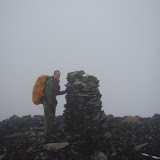In the spring Nancy and I had made plans to hike the Chilkoot with the twins and possibly joined by my dad. My dad was the chief ranger at Klondike Gold Rush Park and as a kid I hiked the Chilkoot trail several times. I have pretty fond memories of hiking the trail with my dad and was looking forward to sharing the experience with the twins – while they are much younger than I was when I first hiked the trail, I figured that they would still enjoy it. Our adventure started early Saturday morning, as we left Fairbanks on the long drive to Skagway. Our plan was to spend two days driving to Skagway, five days hiking the Chilkoot, then two days driving back. My dad decided to join us, so we planned to rendezvous with him in Tok (he would be driving from Wasilla), and he would join us for the rest of the drive. We left town bright and early Saturday morning, and after several hours, arrived in Tok and meet up with my Dad.
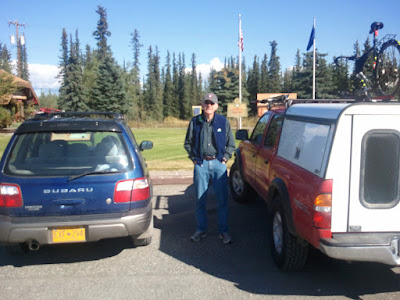
The twins got out of the car to be de-wiggled – fortunately Tok features two visitor centers complete with taxidermied mega fauna and large lawns to run around in – ideal places for the twins to explore and burn off energy.
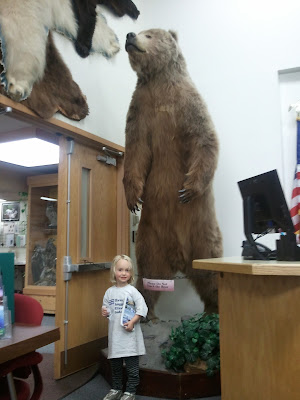
One of the visitor centers also included a place to play hop scotch.
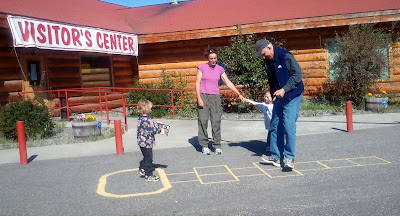
After lots of running around, the twins (and my Dad) got most of their wiggles out and we got back in the car to drive to Congdon Creek Campground in the Yukon Territories. Campgrounds in the Yukon always seem to be in great shape – clean and well maintained. Congdon Creek campground is on Kluane Lake and is very scenic.
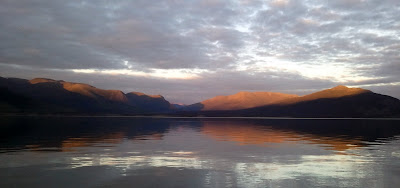
The twins spent the evening building small boats and sending them off into the lake, while Nancy and I watched. My dad is an early to bed and early to rise sort of guy, and retreated to his tent soon after we got our camp site arranged. The next day we zoomed off down the road towards Skagway and just before Whitehorse, we made a side trip to Takhini Hotsprings. I spent a lot of time at Takhini as a kid. Whitehorse was the nearest city of any size (possibly the only one) accessible from Skagway by road, and so my folks made regular trips to Whitehorse to do grocery shopping. These trips would often involve dropping the older Cable kids off at the hot springs to splash around while my folks did their shopping.. Spending the day at the hot springs was much more fun than helping my folks shop for groceries, so I have fond memories of the place. The twins had a blast splashing around in the warm water.

The hot springs were only slightly changed from when I was a kid – they are a bit cleaner now and have a few extra bells and whistles but otherwise it’s pretty much just like when I was a kid. After spending two hours or so the twins (and to some extent their parents ) were wore out and we got back in the truck for the final 100 miles or so to Skagway.
Upon arriving in Skagway we dropped by the park office to get our official “talking to” about hiking the Chilkoot trail (like most pre-hiking lectures it mostly could be summarized in three words – “Don’t be stupid”), got our official permits, and then we were good to go. We spent a bit of time wandering around Skagway..
The character of the town has changed quite a bit from the town I grew up in – there are lots of new houses, lots of new summer-only shop fronts.. After seeing the sights we stashed my bike in an out-of-the way bike rack and headed out of town to Dyea to camp for the evening. The morning soon arrived and off we went, starting the hiking section of our adventure.
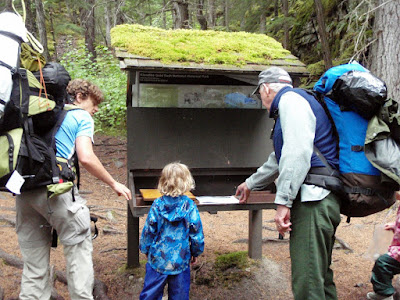
The twins started out hiking..
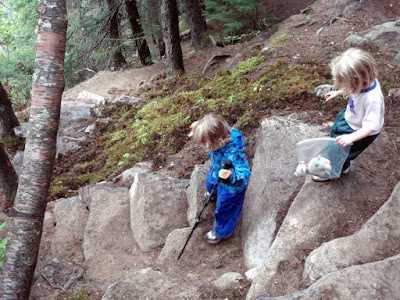
The first day was a standard Skagway day – mostly cloudy and damp. It rained lightly on and off.. fortunately we were well prepared, and had rain coats for everyone, including the stuffed animals.

Hiking is of course hard work, and requires lots and lots of snacking.

After three miles or so, the twins started slowing down and nap time arrived. The twins then were bundled up and stuffed into the backpacks for the most of the remaining hiking for the day.

This pattern continued throughout the rest of the trip – the twins start off hiking, they hike until nap time, then get a ride during nap time, and finish the day hiking, except for the day where we went over the pass (more on that later).
Our first day of hiking was super mellow – our destination for the evening was Finnegan’s Point, which is around five miles from the starting point. The Chilkoot trail is in great shape. There is a long section with boardwalk that crosses a set of beaver dams that was a pretty interesting.
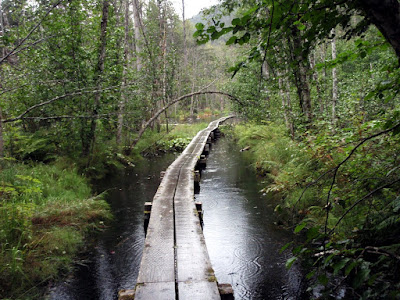
When we arrived at the Finnegan’s Point campsite, we found we had the place to ourselves. Finnegan is the first campground and an easy walk from the trail head, so most folks press on to Canyon City or beyond. Klondyke National Park now requires folks to “book” each of the campsites, so we picked Finnegan’s since we did not know when we would be heading down the trail.. since we starting hiking mid-morning we had a short day. This left us with quite a bit of time to goof off with at the first campground and the twins made the best of it by exploring! The big spruce trees were something quite new to them, and they had quite a bit of fun playing around the with the exposed roots.

On the American side the campsites had warming shelters with wood stoves – which was a new experience for me. It was nice to have a dry place to hang out in, though the wall tents are pretty dark and gloomy. The first warming tent had some very neat wooden dumbbells that I expect the trail crew had fun constructing.
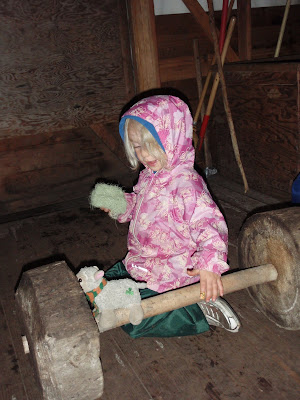
Another interesting feature that had been added in the last ten years since I hike the trail was that every site had tent platforms, which made finding a level, dry spot a lot simpler than in the past. Alas, my tarptent was a bit longer than I think they expected tents using the platforms to be but it all worked out.

The next day we headed off to Sheep Camp. My dad took off early and zoomed ahead, making it to Sheep Camp in time to get a nice afternoon nap. The rest of us walked Twin speed to Canyon City. Hiking speeds are a bit slower when your legs are only a foot and a half long.

Canyon City was much like I remember from visits as a kid, though the shelter cabin had undergone renovation and had a new floor, roof, and wood stove.
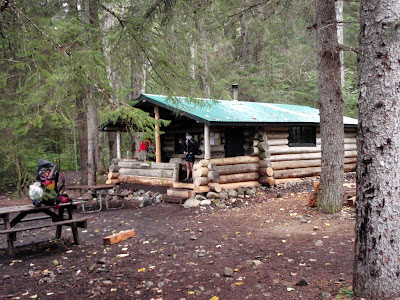
I have very strong memories of some rocking chairs carved from stumps by chainsaws by some locals who used the cabin as a base of operations for trapping during the winter, and was excited to see they were still there.
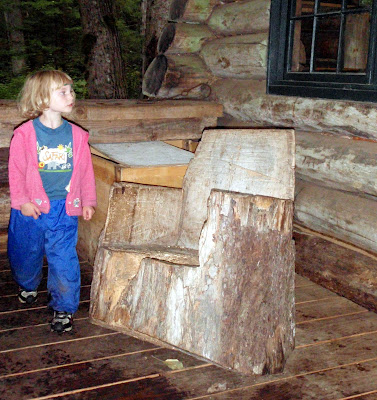
After a brief stop at Canyon City, we headed off down the trail to Sheep Camp. We stopped briefly at the old Canyon City town site, and the girls had fun crossing the very bouncy suspension bridge.
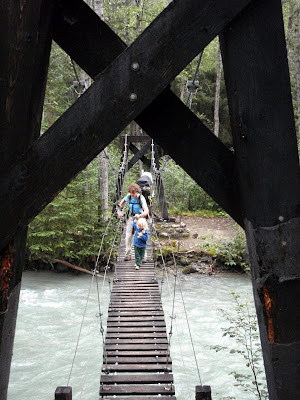
Soon after Sheep Camp we reached the twin’s nap time and they got loaded up and snoozed most of the way to Sheep Camp. The trail past Canyon City winds though drier fir forest and has wonderful views of the Nourse River.
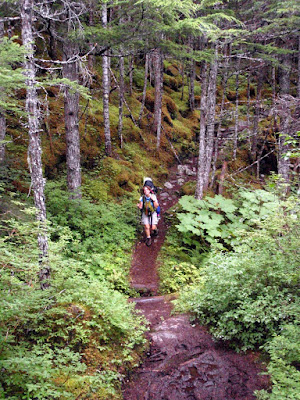
Just before we reached Sheep Camp, we encountered a huge posse working away making the last mile or so of trail before the campground at Sheep Camp more pleasant. The girls were awake by this time and were mellowing out in the backpacks and were very impressed by all the activity.

Sheep Camp has changed a lot since I last visited – the shelter cabin was missing its roof..
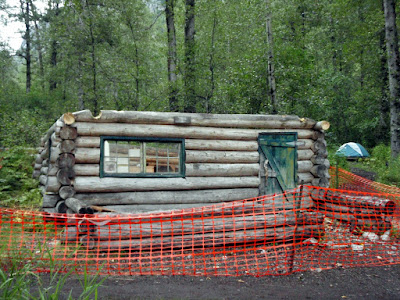
Several warming huts had been installed..

And there were a abundance of dry tent platforms (quite a luxury!).
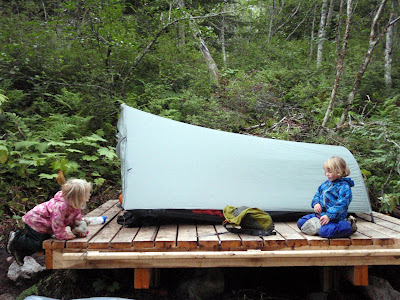
The warming huts had wood stoves and much to my amusement these stoves were burning pieces of the old shelter cabins roof supports. The girls quickly pressed the firewood into an alternate use – mainly furniture for their stuffed animal friends.
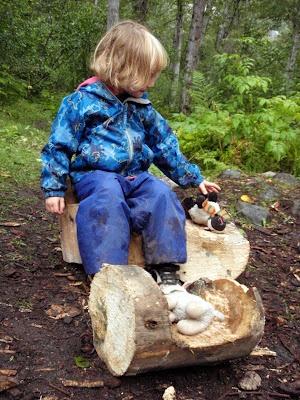
Sheep Camp was the first campground we shared with other campers, and since it was near full, there were a lot of people. Much to my surprise I bumped into an old boss of my who was hiking the trail with some other folks from Fairbanks – its a very small world! We enjoyed a fine dinner of cheesy rice, and then went to bed in order to get a good start in the morning.
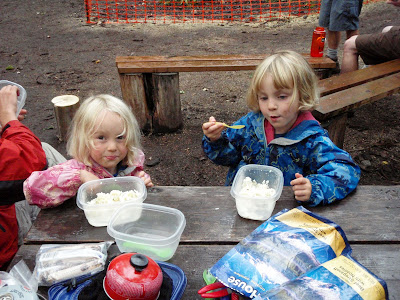
The next day we would be going over the pass, which is the only challenging day on the trail. Our plan was to get an early start and to carry the twins to the base of the steep climb, then have the twins hike up the golden stairs to the top of the pass. The base of the climb is called the “Scales”, as it is where the packers in the old days would re-weigh their loads and charge extra. We got a fairly early start the next day and were on the trail by 7. The twins were a little nonplussed by the early wakeup but didn’t complain too much as they did get to ride in the backpacks rather than having to start hiking right away.

My Dad zoomed off before we were awake and moving – 20 years of commuting 45 minutes one way have made him a perennially early riser, so he was up at 5:30 and off by 6 or so in the morning.
The first four miles or so before the scales are fairly mellow but definitely uphill. As we climbed up to the start of the pass, we gradually left the trees behind and were rewarded by constantly improving views of the surrounding hills.
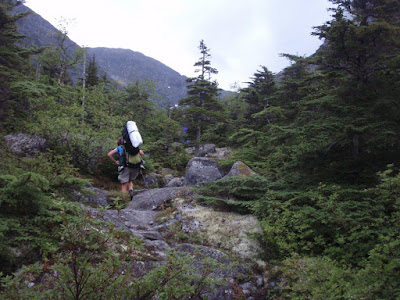
The general quality of the artifacts has definitely gone downhill since I last hiked the trail, and this is most noticeable in the pass. The old wooden structures and the tramway tower were in quite a bit worse shape – I guess over 100 years of being exposed in a windy, snowy pass have taken their toll.
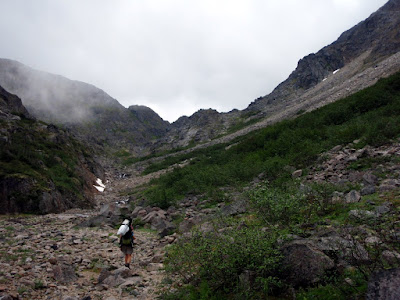
Eventually we reached the Scales and the twins were unloaded. Without the twins in them, the backpacks seemed almost impossibly light.

The twins really enjoyed this section of trail – there are artifacts everywhere, and lots of things to see. The girls seemed most impressed by the boot soles (there are lots, and lots of boot soles along the Chilkoot Trail) and the horse bones.
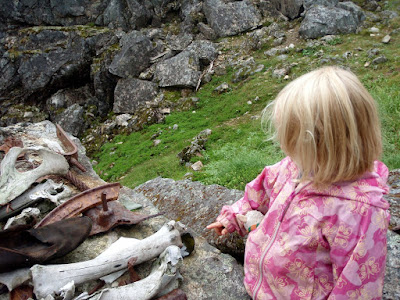
After the Scales came the golden stairs. The golden stairs is the area that shows up in the classic photos of the Chilkoot. The twins really enjoyed climbing the pass – there was lots of scrambling and climbing.
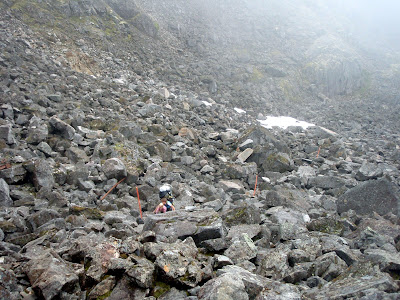
Strangely the twins seemed to hike up the pass at about the same rate as some of the adults… which is amazing as adults’ legs are around a three times longer…
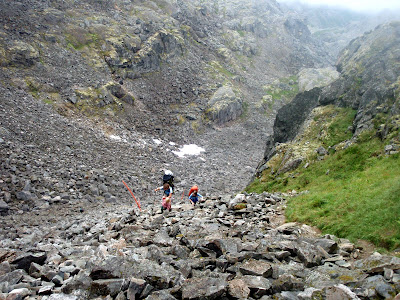
Eventually we made it over the pass and into Canada. Molly and I were the first over and were met by a very friendly warden (the Parks Canada equivalent of a ranger) who was very impressed by the twins and kept offering me coffee and tea. He knew my Dad from way back and apparently had spent the entire morning chatting away and drinking coffee with him. Dad was the first person over the pass that morning, at a little before 9, and apparently had left the wardens’ hut at around 11 – a hour or so before we arrived. After a brief stop at the hut we headed off in a hurry to get to the easy walking trail past Stone Crib. Stone Crib is a large area just below the pass on the Canadian side that is filled with artifacts of all sorts. After Stone Crib the trail becomes pretty tame and easy walking. The twins were quite overdue for their naps and we loaded them up into the packs and they were soon asleep. After several hours of travel we arrived at the first campsite on the Canadian side – Happy Camp.
I had never really stopped at Happy Camp before – in the past I just blew though these sections of trail and went from Sheep Camp to Lindemen in one day, but it was a surprisingly nice campsite. There is an enclosed shelter with no stove that is quite pleasant, and lots of raised tent platforms. The twins enjoyed Happy Camp immensely.

Amazingly Happy Camp is situated in the middle of a huge patch of blueberries, and much to my surprise, no one was picking them. I spend most of the afternoon picking and eating blueberries, occasionally with the help of the twins – yum, yum. The twins generated some interesting interactions with our fellow Happy Campers – twice some small parties of manly-men were sitting around discussing the trail and how hard it was, only to notice the kids and then have their bubble burst when it was confirmed that the twins did in fact walk up the pass under their own power. Ah, life is hard.
In the morning we left Happy Camp and started on our way to Bare Loon Lake.

This section of trail is beautiful, with wonderful high alpine hiking, scenic lakes, and wonderful hills.

Long Lake was particularly beautiful..
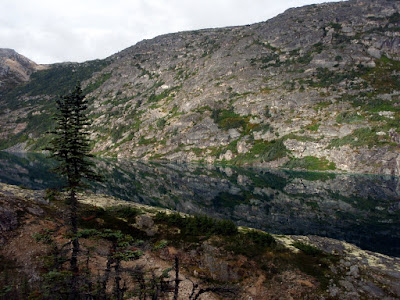
The twins walked from Happy Camp to Deep Lake and made fairly good progress for little folks.
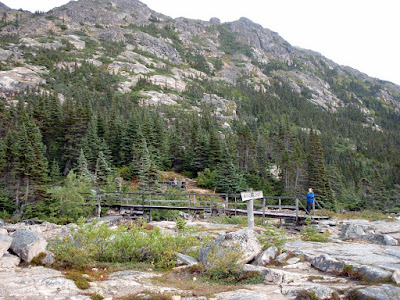
At Deep Lake the twins loaded up in the the backpacks and started snoozing while we zoomed down the trail. After Deep Lake the trail parallels a very scenic canyon that alas did not look very pack-raftable. After Deep Lake the trail heads back into forest, starting with spruce forest, then turning into mixed spruce and pine, and finally into pine forest – its quite a interesting couple of miles.
There are a couple of interesting artifacts along this section of trail, including a very neat boat frame.

This section of trail was always exciting for me as a kid. The pine forests seemed almost magical, all long needles and dryness, quite a change from the constant damp of the coastal rain forests I was used to around Skagway. Eventually we arrived at Lindeman.
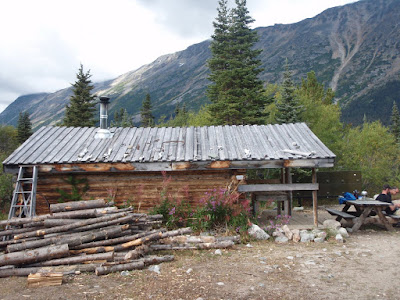
We spend a hour or so exploring Lindeman. Dad attempted to hunt down some more Wardens to chat with while the twins and I explored the exhibits. Lindeman has a tent with books about the gold rush and photos from that era. Lindemen had not changed much since I was a kid – it still looks and feels the same. After spending about an hour looking around we headed out for our destination for the evening – Bare Loon Lake.

Bare Loon Lake is a scenic campsite near a shallow lake (thus the name – oh so tricky) nestled among large pine trees. It was our final evening on the trail and the twins enjoyed it immensely. The weather was quite nice except for a very brief storm during which everyone hovered inside the cooking shelter.
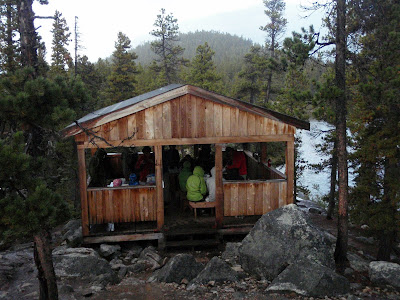
The fine weather brought everyone out of their tents and I got to see a lot more of our fellow campers. It was pretty amazing the stuff some of the folks brought – Fifths of fancy single-malts with the original metal sleeves and glass containers, propane stoves.. some of it was quite boggling. The next day we headed out to hike the final three miles or so to Bennett. The twins were not particularly excited to be rousted out of their sleeping bags..

But eventually we got going.
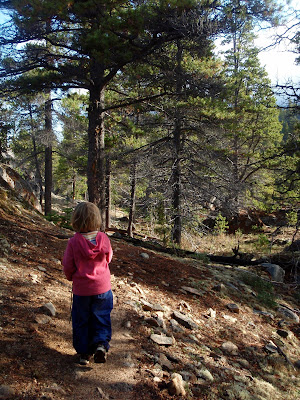
We arrived at Bennett well before the train arrived, and after poking around, stuck our heads inside the train depot to check on lunch. Lunch turned out to be all you can eat soup, bread, and pie – yum yum!
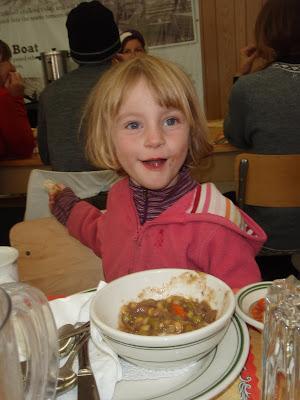

After lunch we watched the train arrive, then got on board.
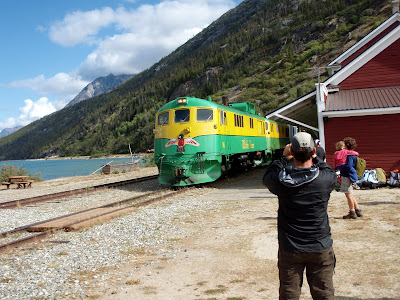
The train ride was mostly uneventful, except for the very over the top narration by an invisible guide. Soon we were back in Skagway and off to get clean and have a dinner of surprisingly good Indian food. The next morning we headed back to Fairbanks. On the way back though Whitehorse we stopped at the Yukon Beringia Interpretive Centre , which was surprisingly good.

We spend the night at a campground just outside Tok, and were back in Fairbanks the following day before 1pm, with more than enough time for the kids to attend one of their classmates’ birthday celebrations.
This was a fantastic trip, and highly recommended. We did it in slow mode, but it could be done as a two night, three day trip quite easily without much hurrying. The hike is fairly remote feeling, but expect lots of people – this is not a hike to escape the madding crowds or for the antisocial. I have not done it as a day hike before, but I expect its a great long day hike. Doing it as day hike is also a great way to get out of the permitting complications – apparently only overnight users require permits. The record time is apparently around five and a half hours – in case one wants to run it.
